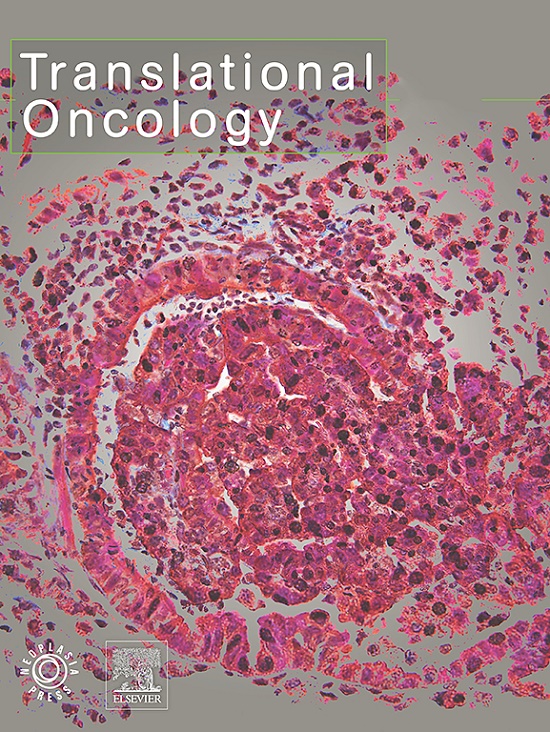尼拉帕利干扰胰腺导管腺癌中的自噬体-溶酶体融合,对吉西他滨耐药的 PDAC 具有抗癌潜力
IF 5
2区 医学
Q2 Medicine
引用次数: 0
摘要
虽然聚(二磷酸腺苷-核糖)聚合酶抑制剂(PARPi)已在部分胰腺导管腺癌(PDAC)患者中取得了特定的临床疗效,但 PARPi 尼拉帕利在 PDAC 中的潜在作用仍需进一步探索。在这项研究中,我们证实尼拉帕利在体外和体内都对 PDAC 的自噬有明显的抑制作用。从机理上讲,这种抑制作用主要归因于尼拉帕利能够破坏自噬体和溶酶体之间的融合过程,同时可能对自噬的初始阶段产生相对较小的影响。观察到的阻断效应可能是通过调节ERK信号通路介导的,应用ERK抑制剂(FR180204)可减轻这种效应。值得注意的是,尼拉帕利和吉西他滨的联合治疗方案未能在野生型 PANC-1 细胞中产生预期的协同效应,反而表现出明显的拮抗作用。不过,在吉西他滨耐药的 PANC-1 细胞中,尼拉帕尼和吉西他滨的组合表现出适度的相加效应。此外,与野生型PANC-1细胞相比,尼拉帕利在体外和体内对吉西他滨耐药的PANC-1细胞具有更强的细胞毒性。我们的研究证实,尼拉帕利能抑制PDAC晚期自噬,可能是治疗吉西他滨耐药PDAC的一种有价值的挽救疗法。进一步的临床研究是合理的。本文章由计算机程序翻译,如有差异,请以英文原文为准。
Niraparib perturbs autophagosome-lysosome fusion in pancreatic ductal adenocarcinoma and exhibits anticancer potential against gemcitabine-resistant PDAC
While poly (adenosine diphosphate-ribose) polymerase inhibitors (PARPi) have achieved specific clinical benefits in a subset of pancreatic ductal adenocarcinoma (PDAC) patients, the potential role of the PARPi niraparib in PDAC necessitates further exploration. In this study, we demonstrated that Niraparib exhibited a pronounced inhibitory effect on autophagy in PDAC both in vitro and in vivo. Mechanistically, this inhibition was primarily attributed to niraparib's ability to disrupt the fusion process between autophagosomes and lysosomes, while potentially exerting a relatively minor impact on the initial stage of autophagy. The blockade effect observed may be mediated via modulation of the ERK signaling pathway, and this effect can be mitigated by the application of an ERK inhibitor (FR180204). Notably, the combined treatment regimen of niraparib and gemcitabine failed to elicit the anticipated synergistic effects in wild-type PANC-1 cells, instead exhibiting pronounced antagonistic interactions. However, in gemcitabine-resistant PANC-1 cells, the combination of niraparib and gemcitabine exhibited modest additive effects. Furthermore, niraparib demonstrated a heightened cytotoxic potency against gemcitabine-resistant PANC-1 cells compared to wild-type PANC-1 cells, both in vitro and in vivo. Our research established that niraparib inhibits late-stage autophagy in PDAC, potentially representing a valuable salvage therapy for gemcitabine-resistant PDAC. Further clinical studies are justified.
求助全文
通过发布文献求助,成功后即可免费获取论文全文。
去求助
来源期刊

Translational Oncology
ONCOLOGY-
CiteScore
8.40
自引率
2.00%
发文量
314
审稿时长
54 days
期刊介绍:
Translational Oncology publishes the results of novel research investigations which bridge the laboratory and clinical settings including risk assessment, cellular and molecular characterization, prevention, detection, diagnosis and treatment of human cancers with the overall goal of improving the clinical care of oncology patients. Translational Oncology will publish laboratory studies of novel therapeutic interventions as well as clinical trials which evaluate new treatment paradigms for cancer. Peer reviewed manuscript types include Original Reports, Reviews and Editorials.
 求助内容:
求助内容: 应助结果提醒方式:
应助结果提醒方式:


